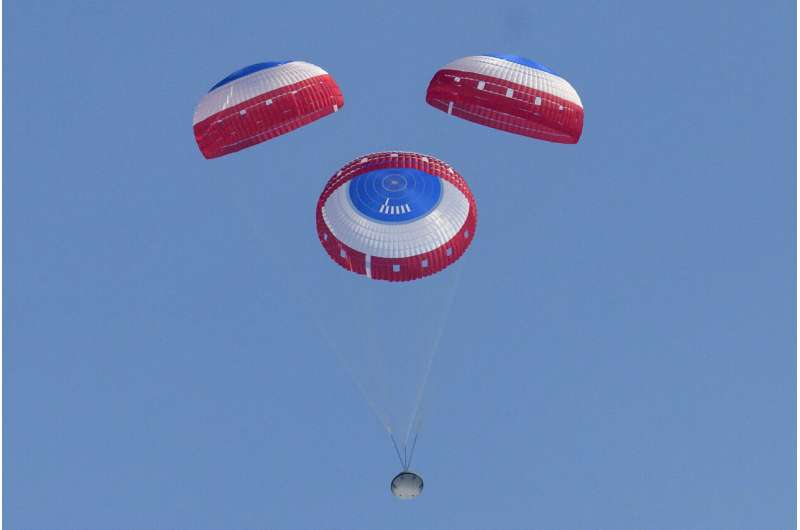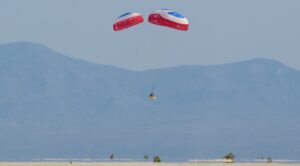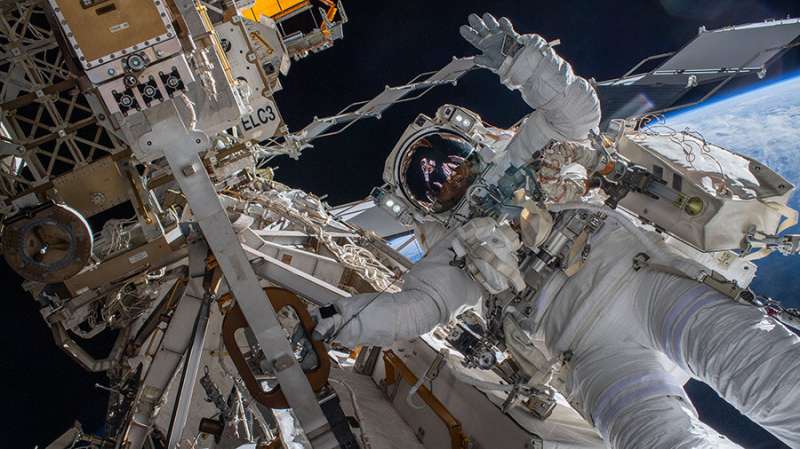NASA's Perseverance rover's playlist like no other on Mars
Thursday, 26 May 2022 09:51 Since NASA's Perseverance rover landed on Mars, its two microphones have recorded hours of audio that provide valuable information about the Martian atmosphere.
Baptiste Chide, of Los Alamos National Lab, will discuss the importance of this acoustical information in the presentation, "Mars soundscape: Review of the first sounds recorded by the Perseverance microphones," at the 182nd Meetin
Since NASA's Perseverance rover landed on Mars, its two microphones have recorded hours of audio that provide valuable information about the Martian atmosphere.
Baptiste Chide, of Los Alamos National Lab, will discuss the importance of this acoustical information in the presentation, "Mars soundscape: Review of the first sounds recorded by the Perseverance microphones," at the 182nd Meetin Putting the future in FutureEO
Thursday, 26 May 2022 09:45
With scientific excellence at the very heart of ESA’s FutureEO programme, participants at this week’s Living Planet Symposium have been making it clear that new research missions to advance Earth science must continue to be realised in the future.
Boeing capsule lands back on Earth after space shakedown
Thursday, 26 May 2022 06:23
Boeing's crew taxi returned to Earth from the International Space Station on Wednesday, completing a repeat test flight before NASA astronauts climb aboard.
It was a quick trip back: The Starliner capsule parachuted into the New Mexico desert just four hours after leaving the orbiting lab, with airbags attached to cushion the landing. Only a mannequin was buckled in.
Aside from thruster failures and cooling system snags, Starliner appeared to clinch its high-stakes shakedown cruise, 2 1/2 years after its botched first try. Flight controllers in Houston applauded and cheered the bull's-eye touchdown.
"It's great to have this incredible test flight behind us," said Steve Stich, director of NASA's commercial crew program. He described the demo as "extremely successful," with all objectives met.
What can satellites reveal about climate tipping points?
Thursday, 26 May 2022 06:01
The effects of our warming climate are seen across a multitude of measures, usually as incremental changes: more frequent extreme weather, heatwaves, droughts and wildfires. The cumulative impact of these changes, however, can cause fundamental parts of the Earth system to change more quickly and drastically. These ‘tipping points’ are thresholds where a tiny change pushes the system into an entirely new state.
This week, at ESA’s Living Planet Symposium, scientists came together to discuss the latest research evidence for climate tipping points and identify the opportunities and challenges of using remote sensing data to understand them.
Space logistics experts broadly endorse standards
Wednesday, 25 May 2022 23:31
A panel of space logistics experts underscored the importance of open standards to encourage the growth of the market.
The post Space logistics experts broadly endorse standards appeared first on SpaceNews.
Boeing Starliner completes key test mission to ISS, with some hiccups
Wednesday, 25 May 2022 23:01 Boeing's Starliner capsule returned to Earth Wednesday in the final step of a key uncrewed test flight to prove itself worthy of providing rides for NASA astronauts to the International Space Station.
The spaceship landed in a puff of sand at 4:49 pm local time (2249 GMT) in the New Mexico desert, wrapping up a six-day mission crucial to restoring Boeing's reputation after past failures.
Boeing's Starliner capsule returned to Earth Wednesday in the final step of a key uncrewed test flight to prove itself worthy of providing rides for NASA astronauts to the International Space Station.
The spaceship landed in a puff of sand at 4:49 pm local time (2249 GMT) in the New Mexico desert, wrapping up a six-day mission crucial to restoring Boeing's reputation after past failures. Starliner concludes OFT-2 test flight with landing in New Mexico
Wednesday, 25 May 2022 22:18
Boeing’s CST-100 Starliner safely landed in New Mexico May 25, concluding a six-day uncrewed test flight to the International Space Station.
The post Starliner concludes OFT-2 test flight with landing in New Mexico appeared first on SpaceNews.
Gogo’s OneWeb partnership could face Starlink in business aviation market
Wednesday, 25 May 2022 20:28
Gogo is planning to use OneWeb satellites in a partnership that could see it take on Starlink in an emerging business aviation market for low Earth orbit services.
The post Gogo’s OneWeb partnership could face Starlink in business aviation market appeared first on SpaceNews.
Virgin Orbit expects first U.K. launch in August
Wednesday, 25 May 2022 20:13
Virgin Orbit expects to perform its first launch from England in late August, pending award of a British launch license, a company executive said May 25.
The post Virgin Orbit expects first U.K.
BlackSky, Maxar, Planet win 10-year NRO contracts for satellite imagery
Wednesday, 25 May 2022 16:02
The National Reconnaissance Office announced May 25 it awarded BlackSky, Maxar Technologies and Planet Labs 10-year contracts to provide satellite imagery for U.S. intelligence, defense and federal civil agencies.
The post BlackSky, Maxar, Planet win 10-year NRO contracts for satellite imagery appeared first on SpaceNews.
Industry looks to decentralized approaches to space sustainability
Wednesday, 25 May 2022 15:17
As governments make slow progress on space traffic management systems, companies may be able work together more quickly to develop processes to support space sustainability.
The post Industry looks to decentralized approaches to space sustainability appeared first on SpaceNews.
Spacesuits are leaking water and NASA is holding off any spacewalks until they can solve the problem
Wednesday, 25 May 2022 13:31
NASA's spacesuits are getting old. The extra-vehicular mobility units—EMUs for short—were designed and built for spacewalks outside NASA's space shuttles, which flew for the last time in 2011. Nowadays, the EMUs are an integral part of maintaining and upgrading the International Space Station (ISS) exterior, providing the crew with the ability to live and work in the vacuum of space for extended periods of time (spacewalks regularly last from 6 to 8 hours). However, at the end of the most recent spacewalk on March 23, NASA astronaut Kayla Barron discovered water in the helmet of German astronaut Matthias Maurer while she helped him remove the suit.
Historic Greenland ice sheet rainfall unravelled
Wednesday, 25 May 2022 12:30
For the first time ever recorded, in the late summer of 2021, rain fell on the high central region of the Greenland ice sheet. This extraordinary event was followed by the surface snow and ice melting rapidly. Researchers now understand exactly what went on in those fateful summer days and what we can learn from it.
From Rome to Bonn by bike
Wednesday, 25 May 2022 10:55 Image:
Omar Di Felice, an extreme cyclist, has biked from Rome to Bonn to take part at ESA’s Living Planet Symposium. Tune in today at 15:30 live from Bonn on ESA Earth Observation Instagram as he’s joined by ESA Astronaut Luca Parmitano and ESA CryoSat Mission Geophysicist Alessandro di Bella.
Image:
Omar Di Felice, an extreme cyclist, has biked from Rome to Bonn to take part at ESA’s Living Planet Symposium. Tune in today at 15:30 live from Bonn on ESA Earth Observation Instagram as he’s joined by ESA Astronaut Luca Parmitano and ESA CryoSat Mission Geophysicist Alessandro di Bella. Boeing's Starliner faces one more challenge as it returns to Earth
Wednesday, 25 May 2022 10:44 Boeing's Starliner capsule is readying to return to Earth on Wednesday in the final step of a key test flight to prove itself worthy of providing rides for NASA astronauts to the International Space Station.
The spaceship is scheduled to autonomously undock at 2:36 pm Eastern Time (1836 GMT) and touch down in New Mexico just over four hours later, at 2249 GMT, wrapping up a six-day mission c
Boeing's Starliner capsule is readying to return to Earth on Wednesday in the final step of a key test flight to prove itself worthy of providing rides for NASA astronauts to the International Space Station.
The spaceship is scheduled to autonomously undock at 2:36 pm Eastern Time (1836 GMT) and touch down in New Mexico just over four hours later, at 2249 GMT, wrapping up a six-day mission c 